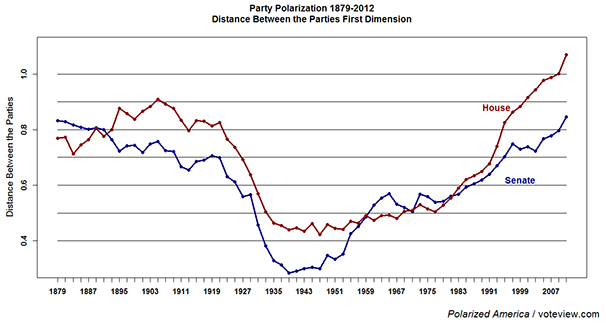It may be tough to imagine, but political parties don’t always grow further apart. Occasionally, depolarization happens.
The graph below shows the distance between the major parties in Congress since 1879, courtesy of Voteview. There has clearly been a profound trend toward greater polarization since the 1940s, and we’ve reached the point today where we seem to have the most polarized House of Representatives and Senate in history. These trends show no signs of abating. Yet polarization was also very high in the late 1800s, and it collapsed. There really was a period of bipartisanship in the mid-20th century.

Similarly, as Boris Shor has shown, while most state legislatures have grown more polarized in the last two decades, 16 of the 99 state legislative chambers have actually depolarized during this time period, including the Wyoming House and the Ohio Senate.
These examples of depolarization, while intriguing, have unfortunately convinced a great many would-be reformers that reversing polarization is easy, and that some tinkering with election laws can bring about dramatic changes in the way elected officials behave. For the most part, that’s just not true. In this paper I did for Brookings recently, I reviewed several of the more popular ideas for reducing partisanship in legislatures, from open primaries to redistricting reform to campaign finance restrictions. Almost none of the reforms I examined showed any promise for mitigating partisanship, and for those that did, the effects were marginal at best.
Perhaps tinkering around the edges of polarization is enough. But serious shifts in the direction of polarization tend to be the result of massive historical forces rather than clever ballot reforms. Partisanship collapsed in Congress in the early 20th century due to the rise of the Progressive movement (which drew from both major parties) and the fact that the Democratic Party was becoming the more liberal party even while its most loyal supporters—southern whites—remained some of the most conservative voters in the nation. With each major party containing strong liberal and conservative elements, it was difficult to identify major differences between the two.
Perhaps tinkering around the edges of polarization is enough. But serious shifts in the direction of polarization tend to be the result of massive historical forces rather than clever ballot reforms.
This was not the sort of transformation of a party system that anyone consciously engineered. Indeed, it would have been hard to conceive of such a plan in advance or enact it once conceived. To the extent that individuals or groups were trying to guide the parties of that time, it was because they had particular policy objectives, such as putting the federal government in charge of improving life for racial minorities or protecting the rights of labor union members. Just reducing partisanship for its own sake has rarely been a serious policy objective.
Could we see some sort of historical party shift today that might undermine polarization? This is something Hans Noel speculates about towards the end of his new book Political Ideologies and Political Parties in America. As Noel notes, what makes our current Republican-Democrat partisan divide so durable is that it neatly lines up with the conservative-liberal ideological divide. This confluence of party and ideology is relatively new in American history. To undermine the party divide, he suggests, we’d need to see a shift in today’s ideological coalitions.
Perhaps libertarianism could be a source of this. That is, maybe those disturbed by the recent NSA spying revelations and the use of drones to kill Americans without due process could form some sort of an alliance with those who want to restrain federal intervention in the economy. Perhaps this wouldn’t make for enough people to become a major party by itself, but it could become pivotal enough in elections to force some sort of realignment. Perhaps they could attract activists who care about other issues as well, and maybe even exploit current fissures in the Republican Party to form a formidable third party.
I am doubtful (as is Noel) that this will amount to much. Libertarianism has rarely shown an ability to attract a large percentage of the population; to the typical voter, for every libertarian stance that seems appealing another seems completely repugnant. And the current system has demonstrated itself to be remarkably durable and resistant to such appeals. Yet if we are to see a substantial change in the direction of partisanship in this country, it will need to come from some sort of shift or the emergence of a new issue that undermines the current ideological divide. Short of that, we’re just tinkering around the edges, and things can still get a whole lot more partisan than they currently are.



